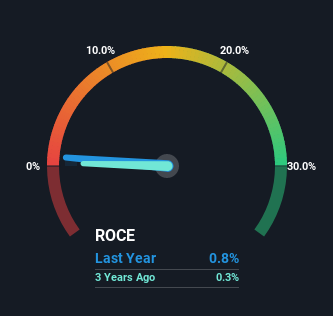- South Africa
- /
- Trade Distributors
- /
- JSE:MMP
Here's What's Concerning About Marshall Monteagle's (JSE:MMP) Returns On Capital
If you're looking at a mature business that's past the growth phase, what are some of the underlying trends that pop up? A business that's potentially in decline often shows two trends, a return on capital employed (ROCE) that's declining, and a base of capital employed that's also declining. Trends like this ultimately mean the business is reducing its investments and also earning less on what it has invested. And from a first read, things don't look too good at Marshall Monteagle (JSE:MMP), so let's see why.
What Is Return On Capital Employed (ROCE)?
Just to clarify if you're unsure, ROCE is a metric for evaluating how much pre-tax income (in percentage terms) a company earns on the capital invested in its business. To calculate this metric for Marshall Monteagle, this is the formula:
Return on Capital Employed = Earnings Before Interest and Tax (EBIT) ÷ (Total Assets - Current Liabilities)
0.008 = US$894k ÷ (US$150m - US$38m) (Based on the trailing twelve months to March 2022).
Thus, Marshall Monteagle has an ROCE of 0.8%. In absolute terms, that's a low return and it also under-performs the Trade Distributors industry average of 13%.
Check out our latest analysis for Marshall Monteagle

While the past is not representative of the future, it can be helpful to know how a company has performed historically, which is why we have this chart above. If you're interested in investigating Marshall Monteagle's past further, check out this free graph of past earnings, revenue and cash flow.
What Can We Tell From Marshall Monteagle's ROCE Trend?
We are a bit worried about the trend of returns on capital at Marshall Monteagle. About five years ago, returns on capital were 7.7%, however they're now substantially lower than that as we saw above. Meanwhile, capital employed in the business has stayed roughly the flat over the period. This combination can be indicative of a mature business that still has areas to deploy capital, but the returns received aren't as high due potentially to new competition or smaller margins. If these trends continue, we wouldn't expect Marshall Monteagle to turn into a multi-bagger.
On a related note, Marshall Monteagle has decreased its current liabilities to 26% of total assets. So we could link some of this to the decrease in ROCE. Effectively this means their suppliers or short-term creditors are funding less of the business, which reduces some elements of risk. Since the business is basically funding more of its operations with it's own money, you could argue this has made the business less efficient at generating ROCE.
The Bottom Line On Marshall Monteagle's ROCE
In summary, it's unfortunate that Marshall Monteagle is generating lower returns from the same amount of capital. Yet despite these concerning fundamentals, the stock has performed strongly with a 71% return over the last five years, so investors appear very optimistic. Regardless, we don't feel too comfortable with the fundamentals so we'd be steering clear of this stock for now.
Marshall Monteagle does come with some risks though, we found 4 warning signs in our investment analysis, and 1 of those can't be ignored...
If you want to search for solid companies with great earnings, check out this free list of companies with good balance sheets and impressive returns on equity.
New: Manage All Your Stock Portfolios in One Place
We've created the ultimate portfolio companion for stock investors, and it's free.
• Connect an unlimited number of Portfolios and see your total in one currency
• Be alerted to new Warning Signs or Risks via email or mobile
• Track the Fair Value of your stocks
Have feedback on this article? Concerned about the content? Get in touch with us directly. Alternatively, email editorial-team (at) simplywallst.com.
This article by Simply Wall St is general in nature. We provide commentary based on historical data and analyst forecasts only using an unbiased methodology and our articles are not intended to be financial advice. It does not constitute a recommendation to buy or sell any stock, and does not take account of your objectives, or your financial situation. We aim to bring you long-term focused analysis driven by fundamental data. Note that our analysis may not factor in the latest price-sensitive company announcements or qualitative material. Simply Wall St has no position in any stocks mentioned.
About JSE:MMP
Marshall Monteagle
An investment holding company, engages in the import and distribution, and property holding businesses in the United Kingdom, South Africa, Europe, and internationally.
Excellent balance sheet with low risk.
Market Insights
Community Narratives



